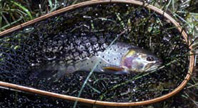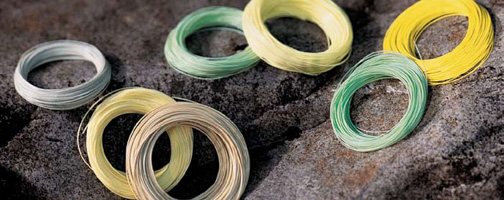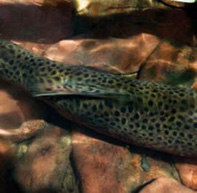Lines
All fly lines are sold in weight numbers that correspond to a particular rod’s slow, medium, or fast action. Simply match the line weight designation to the rod’s action weight number. For example, a five-weight line is designed to cast well with a five-weight rod. The line and rod manufacturers have standardized the number designations. Be careful, however, to avoid confusing a line’s weight with a sinking line’s sink rate number. They do not match. The sink rate number refers to the rate of speed at which the line sinks; likewise, the line’s weight number is based upon the actual weight in grains of the first thirty feet of line.

Floating Lines
Floating lines float because they are less dense than water. Their coating contains tiny air bubbles.
Line makers manufacture three basic types of lines: level, double taper, and weight forward.
Level lines are used primarily for shooting or running lines; moreover, level lines are used in conjunction with shooting heads. Because a smaller diameter line has less surface area and less friction as it shoots

through the guides, flyfishers generally prefer small diameter level lines. Level lines are inexpensive but seldom used as fly lines. Because they lack any tapers, casts with level lines make poor deliveries.
Double taper lines are seldom used, either. True, this is an oversight because double tapers excel at mending, accuracy, and distance. Double tapers also maintain controlled loops and casting form with ease. Unfortunately, double taper lines are larger in volume and quickly fill up a reel spool, leaving less room for backing than weight forward lines. Most fishermen overlook the double tapers and buy the weight forward lines because they think that the “rocket-taper” will improve their casting. The uniform belly thickness and uniform mass of double tapers, however, transmit the casting loop forces evenly. Double tapered lines also last longer. When one taper wears out, the owner can “reverse” the line on the reel by pulling it all off and tying the most heavily used portion onto the spool or backing. For distance casting, I use a line one weight smaller than my rod’s designation. This allows the rod to control a longer line because the line weights are determined by the actual weight in grains of the first thirty feet of line. A line one weight class smaller than the rod’s recommended line is longer, so I might use a four weight line on a five weight rod.
Considering their sales numbers, weight forward lines are the most popular. They have a short double taper section up front with a smaller diameter level running line behind. With the weight of the line up front, a weight forward line is designed to shoot this short double tapered section towards its target. The standard weight forward line has thirty feet in its weight forward section but the remainder of the line is a level shooting line. Other specialized lines have longer weight forward sections up to and over forty feet in length. Because these lines cast more like a double taper up close and because they can cast farther, I prefer these kinds of weight forward lines. Scientific Anglers markets these lines as “distance tapers” and Cortland calls them “long belly lines.” Performing nearly as well as a double taper, the distance tapers take up less room on the reel spool and allow the spool to hold more backing.
Sinking Lines
Essential for fishing still waters, sinking lines come in standard sink and uniform sink designations.
A standard sink line’s belly section sinks deeper than its thinner ends. When fully sunk, the belly of the line is deeper than the end of the fly line, which causes the fly and leader to buoy up above the line’s belly. This buoyancy has its advantages and disadvantages. Suspending the fly up off the bottom makes the fly more visible to the fish and less likely to catch weeds. On the other hand, you may miss strikes because the line’s arch makes it difficult to detect the bite of a soft-taking fish or to react to a very quick take.

The uniform sink lines sink evenly with the belly and tip sections at the same depth. A uniform sinking line can place your fly inside the weed beds but the fly may constantly snag. Hidden in weeds, your fly is less visible to the fish. Furthermore, a fly adorned with weeds is rarely taken. The big advantage of a uniform sinking line is the straight line it creates between you and the fish. Generally speaking, you can more easily detect soft strikes from fish with a uniform sinking line than with a standard sinking line.
When fishing heavily weeded areas, I prefer the standard sinking line because my fly catches fewer weeds and more fish, but when fishing over a clean bottom, I prefer
| Line | Sink Rate (inches per second) | Suspension Depth (feet) |
|---|---|---|
| Intermediate | less 1 inch | 0-5 |
| 1 | 1-1¾ inches | 5-10 |
| 2 | 2½-3 inches | 10-20 |
| 3 | 3½-4 inches | 20-25 |
| 4 | 4½-5 inches | 25-30 |
| 5 | 5-6 inches | 30 |
| 6 | 6¼-7 inches | >30 |
| Deep water express | 7-8 inches | >30 |
| Lead core 450 gr | 7-8¾ inches | >30 |
a uniform sinking line because it detects more strikes.
Sinking lines also come in weight forward and shooting head styles. (I’m unaware of any double tapers.) Shooting heads are usually thirty feet in length, and they are joined to running line or to monofilament.
Manufacturers issue sinking lines with a variety of sinking rates. Sinking lines are numbered as intermediate, 1, 2, 3, 4, 5, and 6. In addition, deep water express and lead core lines are also available. The following table lists sink rates and suspension depths:
The line choice controls your fly’s sinking rate and suspension depth. To sink your fly to a particular depth, use “the countdown method.” After making your cast, pull the line straight and begin counting in seconds as the line sinks. For example, a type two line sinks at two and a half to three inches per second; consequently, a forty second count will place the line about ten feet deep.
This countdown method gives you control over the depth that you fish. Know the depth that you want to fish and select the line that will suspend there. A sinking line’s suspension property is important because it allows you to present your fly at the desired depth throughout the retrieve. The longer the fly stays where the fish are, the more likely the fish will take it. To some degree, the line selection may be more important than the fly selection. I like to target the submerged weed beds and fish my fly about one or two feet above them.
For most of my still water fishing I use an intermediate sinking line, a type 1 sinking line, or a type 2 sinking line. I find the depths of the submerged weed beds, and then I choose the line that will suspend my fly there.
Sink Tip Lines
A sink tip line is composed of a floating line and a five foot to thirty foot sinking head. Sink tip lines are useful for stream fishing. They present streamers and wet flies well. I seldom use sink tips for nymph fishing because the floating line and strike indicator method is superior. Likewise, I rarely use sink tips in still waters because they seem to create a line arch that makes detecting light strikes difficult.
Sink tips are offered in a wide assortment of lengths and sink rates. I usually prefer the shortest sink tip that will reach the stream’s bottom. A convenient way to convert your floating line to a sink tip is to loop on a section of sinking line. Purchase a thirty-foot shooting head in a type four or six density. Cut the head into two foot, three foot, ten foot and fifteen-foot sections. Add loop connections to all section ends. Then simply connect the looped sections to your floating line. By looping together singles and combinations you can create two, three, five, eight, ten, thirteen, fifteen, twenty-five and thirty foot sink tips. Making your own sink tips saves you from having to buy expensive spare reel spools. All you need is your reel with the floating line, and you have less tackle to carry.

© 2025 The Gale Group, Inc. All rights reserved.
© 2025 Perigee Learning LLC. All rights reserved.
LoveTheOutdoors.com is owned and operated by Advameg, Inc. © 2025 Advameg, Inc.
Camping Adventures • Dutch Oven Cooking • Sports Knots
Fly Tying • Freshwater Fishing • Fly Fishing

